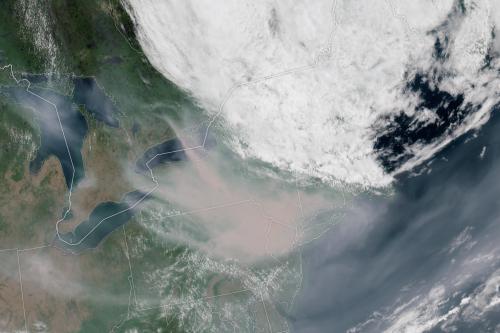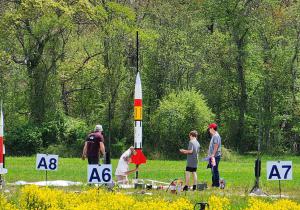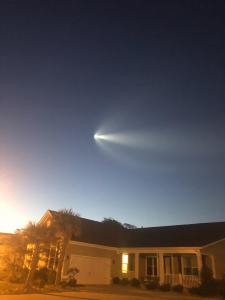Celebration of Space - June 9, 2023
Have you noticed the crazy wildfire smoke over our region this past week? Well that is compliments of some huge wildfires happening in Quebec. Even though the smoke makes the air unsafe, blocks our view of the sky, and doesn’t smell that great; there are some really cool science opportunities here to partake in. All of this smoke has made for some amazing views of Mie Scattering over our region, which is not something we usually see so clearly.
Mie Scattering occurs when large particles of matter end up in the sky. These particles can be anything from sulfur to soot and ash. The particles are larger than your average atoms and molecules in the sky, so large that they do not fit between the wavelengths of blue, green, and part of red light. This causes those colors to scatter, giving the sky a whitish appearance. When this happens only the red wavelengths make it through without scattering, and depending on the intensity, some of the green may make it through. The result are views of the red Sun, red Venus, and the red Moon. This past week we have had stunning views of all of these phenomena! With it being so smoky on Monday and Tuesday that even the sunlight shining on the landscape was red. With the fires persisting, be sure to step outside this week, on a particularly smoky evening, and catch a red view of Venus, then set your alarm for the morning hours before predawn and step outside to catch a view of the reddish Moon. If you are concerned about health effects from the smoke, just dig out that N95 you have sitting around from the pandemic, and breathe cleanly. Check out this picture of Venus, sporting deep red hues, by Frosty Drew Astronomy Team member, Sean Perkins, on June 6th.
This coming Wednesday, June 14, 2023, the Frosty Drew Sky Theatre will celebrate the 14th anniversary of the grand opening. In the late 2000’s, Frosty Drew Observatory Director, Les Coleman, envisioned a theater type environment where live telescopic views can be shown on screen. This concept kicked off the design, and eventual construction of the Frosty Drew Sky Theatre. Before this construction, what is currently the Science Center, was the only facility on the north side of Park Lane on our campus. At the time it was the Frosty Drew Nature Center. The Sky Theatre was built as a large addition to that building. Over the past 14 years, the Sky Theatre has gone through several modifications and upgrades, including faster bidirectional communications with the entire campus, not just the observatory, the ability to broadcast live views from any connected telescope on campus, as well as simultaneous views. Telescope views can be either live streamed, live stacked, or live slide. The projector and screen have been upgraded to a large LED display, and a powerful display server has been integrated which links everything on our campus into the Sky Theatre. This summer we will be showing new features including a collaborative piece with the NASA Solar Dynamics Observatory called The Sun, the first installment of Frosty Drew Project Messier, and slide shows of celestial objects we capture at the Observatory. We will also host several speakers this summer, including the return of Frank Puglia – a huge fan favorite, one of the Chariho Career and Tech Center students that helped design the Project Comet Chaser rocket, dark sky advocate – Bill Steinman, and possibly a special night with the band Triangle Forest. Be sure to plan a visit to Frosty Drew this summer, and take in some time in the Sky Theatre.
This coming Sunday, June 11, 2023, the Rhode Island Model Rocket Association (RIMRA) will be hosting a day of rocket launching at the University of Rhode Island’s Peckham Farm Field. RIMRA launches are always spectacular, and give visitors a chance to experience some of the fascinating aspects of engaging in model rocket building. The June 11th event will bring mid-power and high-power rockets that launch as high as 3,000 feet. The day starts at 8:30 am with setup, followed by first launch around 9:30 am – 10:00 am. The day will continue until rockets are all launched, which is usually around 3:00 pm. Food concession sales will be available, as well as grilling around noon. It is free for spectators, without rockets, to visit, though donations are always appreciated. So make it a day for the family, and set out to Peckham Farm field, with a picnic, or tailgate, and introduce your children to a fantastic STEM activity. Read about event protocols, access, parking, and the overall event.
This coming Wednesday, June 14, 2023, the China National Space Administration’s (CNSA) Tiangong space station will return to the evening sky over the United States offering up fantastic visible passes nightly. Tiangong is not quite as large as the International Space Station (ISS), but it has grown significantly over the past several years, and has become quite bright. Evening passes will continue nightly until June 27th. Since Tiangong orbits at a different inclination than the ISS, we end up experiencing much better placement of the station over our location, which results in many fantastic passes. Here are some viewing opportunities for this coming week:
Wed, June 14 at 9:28 pm, starting in the SSW, rising to 19°, heading towards the SE
Thu, June 15 at 10:04 pm, starting in the SW, rising to 46°, heading towards the SE, and into orbital sunset.
Note that these pass times are applicable for Southern New England, but are generally acceptable for all Northeast sky watchers. At Frosty Drew, we have written our own satellite pass prediction utility which updates overnight each day. It provides a list of very bright satellites that will be visible over a 24 hour period. Tiangong is listed as CSS (TIANHE). Check in daily with our utility at.
This coming Monday, June 12, 2023, starting at 2:40 am, the launch window opens for the launch of the SpaceX Falcon 9 rocket, which is carrying another set of Starlink satellites to orbit. The launch will happen at Cape Canaveral, FL, and may be visible from our location. The launch window stays open until 6:09 am, which is pretty awesome because the best views of launches happen when the launch vehicle enters direct sunlight, but observers are still in darkness. Direct sunlight will illuminate the exhaust plumes of the rocket, making for quite a spectacular view. If looking to try for a view, set out to a location with a good view of the SE → East horizon, and be there for the 2:40 am opening. Depending on the launch, you may see it from home zooming over. SpaceX is notorious for not publishing visibility maps of their launches, so we are unsure if you will see anything. Regardless, it’s a 50 / 50, but if you have ever seen one, it is certainly worth a try. Good luck!
- Author:
- Scott MacNeill
- Entry Date:
- Jun 9, 2023
- Published Under:
- Scott MacNeill's Columns





